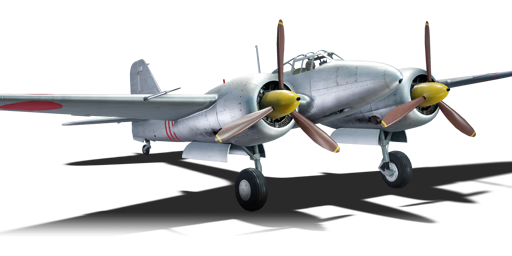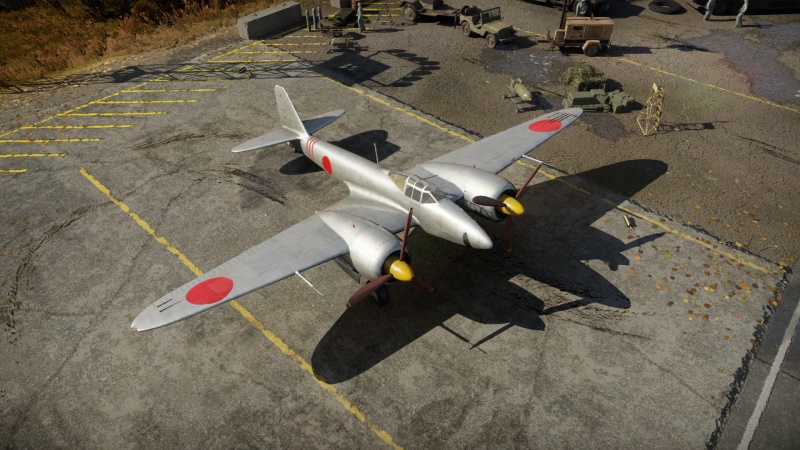Ki-96
Contents
Description
The Ki-96 is a premium rank III Japanese twin-engine fighter with a battle rating of 4.0 (AB) and 3.7 (RB/SB). It was introduced in Update 1.35.
General info
Flight performance
The Ki-96 is a generally smooth flyer and is characterized by its powerful armament, high speed, high climb rate, interceptor spawn and relatively good turn rate. All of these traits make for a solid interceptor that can shred through bombers like a hot katana through wet bamboo.
| Characteristics | Max Speed (km/h at 5,000 m) |
Max altitude (metres) |
Turn time (seconds) |
Rate of climb (metres/second) |
Take-off run (metres) | |||
|---|---|---|---|---|---|---|---|---|
| AB | RB | AB | RB | AB | RB | |||
| Stock | 568 | 553 | 10000 | 25.3 | 25.7 | 14.5 | 14.5 | 380 |
| Upgraded | 634 | 600 | 23.7 | 24.0 | 30.9 | 19.5 | ||
Details
| Features | ||||
|---|---|---|---|---|
| Combat flaps | Take-off flaps | Landing flaps | Air brakes | Arrestor gear |
| ✓ | ✓ | ✓ | X | X |
| Limits | ||||||
|---|---|---|---|---|---|---|
| Wings (km/h) | Gear (km/h) | Flaps (km/h) | Max Static G | |||
| Combat | Take-off | Landing | + | - | ||
| 0 | 310 | 437 | 408 | 260 | ~9 | ~8 |
| Optimal velocities (km/h) | |||
|---|---|---|---|
| Ailerons | Rudder | Elevators | Radiator |
| < 360 | < 400 | < 400 | > 296 |
Survivability and armour
- 12 mm steel plating in the nose
- 16 mm steel plating behind the pilot
- Critical components located at the front of aircraft (fuel, pilot, engine, controls)
- Self-sealing fuel tanks in the wings
Modifications and economy
Armaments
Offensive armament
The Ki-96 is armed with:
- 1 x 37 mm Ho-203 cannon, nose-mounted (25 rpg)
- 2 x 20 mm Ho-5 cannons, chin-mounted (200 rpg = 400 total)
Usage in battles
One should fly the Ki-96 in its stated role: interceptor. When engaging bombers, be sure to approach from oblique angles and never tail one, as you have no bulletproof glass to protect your pilot from snipes. While bombers with good aim can snipe you, you can do the same to their plane in seconds when you land your devastating 37 mm cannon and 20 mm cannon shots. If all you encounter are fighters, it can make for a decent Boom-&-Zoom aircraft with its good speed, climb rate and armament. As a general rule, never turn fight. While the Ki-96 has a good turn rate for a twin-engined fighter, it is out-turned by most of its opposition, and same goes for its speed. With these in mind, always try to engage fighters with an energy advantage, although be careful as the Ki-96's roll rate heavily stiffens above 643 km/h (400 mph), which makes it hard to control at high speeds.
Manual Engine Control
| MEC elements | ||||||
|---|---|---|---|---|---|---|
| Mixer | Pitch | Radiator | Supercharger | Turbocharger | ||
| Oil | Water | Type | ||||
| Not controllable | Controllable Auto control available |
Controllable Not auto controlled |
Controllable Not auto controlled |
Separate | Controllable 2 gears |
Not controllable |
Pros and cons
Pros:
- Powerful offensive armament all mounted in the centre of the plane
- Guns have good ammo capacity
- Fast, quicker than most Japanese planes at the same rank
- Turns well for a twin-engined fighter
- High climb rate
- Thin body means smaller profile to be fired at
- Decent roll rate below 640 km/h
- Responsive elevator
- 360° cockpit view
- Premium rewards
Cons:
- Wings are littered with fuel tanks
- Still outmanoeuvred and outsped by most single-engined fighters
- No bulletproof glass to protect the pilot from getting knocked out
- Good cockpit visibility is hampered by a large amount of structural bars
- Poor energy retention
- Roll rate stiffens above 640 km/h
- 37 mm cannon has relatively low muzzle velocity
History
The Ki-96 was a twin-engined heavy fighter developed by Kawasaki Aeronautics in 1942 after the success of their Ki-45 line. Like the Ki-45, it was a two-seat, twin-engined fighter with larger and more powerful Ha-112 radial engines to replace the Ki-45's Ha-104 engines. It was intended to replace the "Toryu's" for the Imperial Japanese Army Air Service, but the Imperial Japanese Army Aviation Bureau insisted that it be converted to a single-seat fighter. The first prototype made retained the cockpit canopy intended for a two-seat fighter, and the next two prototypes were fitted with smaller canopies.
Despite showing performance exceeding estimates and having excellent handling, the Army's requirements had changed back to two-seat fighters, resulting in production and development on the Ki-96 being halted, with only three prototypes being made. However, the wings and tail unit would later go on to form the Ki-102 wings and tail.
Media
Excellent additions to the article would be video guides, screenshots from the game, and photos.
See also
Links to the articles on the War Thunder Wiki that you think will be useful for the reader, for example:
- reference to the series of the aircraft;
- links to approximate analogues of other nations and research trees.
External links
| Kawasaki Aircraft Industries (川崎航空機工業株式会社) | |
|---|---|
| Biplane Fighters | Ki-10-I · Ki-10-I C · Ki-10-II · Ki-10-II C |
| Fighters | Ki-61-I ko · Ki-61-I otsu · Ki-61-I hei · Tada's Ki-61-I hei · Ki-61-I tei · Ki-61-II Otsu Kai |
| Ki-100 · Ki-100-II | |
| Interceptors | Ki-45 ko · Ki-45 otsu · Ki-45 hei · Ki-45 tei |
| Ki-96 | |
| Ki-102 otsu | |
| Ki-108 Kai | |
| Bombers | Ki-32 |
| Ki-48-II otsu | |
| Captured | ␗Ki-45 hei/tei · ␗Ki-61-I otsu · ▃Ki-61-Ib |
| See also | Kawasaki Shipyard Co. |
| Japan twin-engine fighters and strike aircraft | |
|---|---|
| Navy | |
| Land-based Fighter | |
| J1N | J1N1 |
| J5N | J5N1 |
| Army | |
| Ki-45 | Ki-45 ko · Ki-45 otsu · Ki-45 hei · Ki-45 tei |
| Ki-83 | Ki-83 |
| Ki-96 | Ki-96 |
| Ki-102 | Ki-102 otsu |
| Ki-108 | Ki-108 Kai |
| Ki-109 | Ki-109 |
| Japan premium aircraft | |
|---|---|
| Fighters | Hagiri's A5M4 · A7He1 · Ki-27 otsu Tachiarai |
| Ki-44-II otsu · ▅Bf 109 E-7 · ▅F4U-1A · Ki-100-II · Ki-44-I 34 | |
| ▅Fw 190 A-5 · A7M1 (NK9H) · Tada's Ki-61-I hei · ▅P-51C-11-NT | |
| J2M4 Kai · A6M5 Ko · A6M6c · J2M5 · Ki-87 · J6K1 | |
| Twin-engine fighters | Ki-96 |
| Jet fighters | F-86F-40 JASDF▅ · T-2 Early · F-4EJ ADTW |
| Strike aircraft | ▄AV-8S |
| Bombers | Ki-21-I hei · Ki-48-II otsu · H8K3 · B7A2 (Homare 23) · ▅B-17E |





